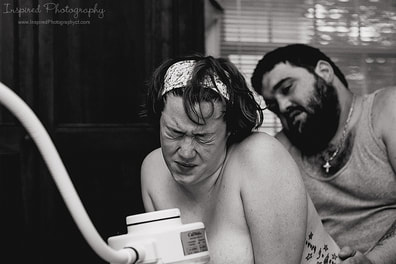|
You may well have heard about the 'transition' stage of labour. The 'I can't do it' stage! It's the scene we've become familiar with in films and TV where labour seems dramatic and the woman appears to be out of control. Often talked about in antenatal classes and between friends, the prospect of this stage can be daunting and worrying for many people. It's so commonly talked about, but not why it happens and how you can be helped through it! So first off. . . why? Well in the first stage of labour as the cervix is opening up, oxytocin levels are high to maintain regular and efficient surges and women are often in a relaxed and comfortable state. Adrenaline is the enemy to this stage as it inhibits the release of oxytocin and endorphins, therefore making labour longer and less comfortable. Around about the time when the cervix has opened up to 7-8cm, the body produces a rush of adrenaline. The aim of this is to wake the birthing woman up, ready to meet her baby and provides a renewed sense of energy. It is also thought that this surge of adrenaline is what initiates the 'pushing' reflex, otherwise known as the foetal ejection reflex (FER). So this adrenaline plays a pretty important role really. But like any normal adrenaline rush, our bodies react quickly and markedly. Some of the effects are a racing heart, feeling clammy, nausea, shivers, panic and agitation to name just a few! For some women, this will be a very obvious reaction and can last from a few minutes up to an hour. For others there will be no outward signs that a shift has occurred. And now, the important bit. . . how as a birth partner you can help a woman in transition. . . * Knowing about this stage and understanding why it occurs is the first step to helping * Positive language and positive affirmations- 'You can do this, you are doing this', 'Look how far you've already come', 'You're amazing', 'You'll soon be meeting your baby' etc. * Touch- Either a firm massage, an anchoring touch or a light touch massage * Skin to skin contact (cuddles, kisses, massage) *Being familiar with breathing techniques and helping her with these if her breathing becomes quicker and shallower (doing these along with her is much more effective than just reminding her of them!) * Aromatherapy *Reminding her of her visualisations and showing her any appropriate images you may have to prompt with these * Just being there. As a birth partner, you are a trusted and 'safe' person, just your presence can help her through the tough parts I hope these tips come in handy and I would love to hear what helped you or your partner through transition! Emma x
0 Comments
|
AuthorEmma Batt, Hypnobirthing Mother of one and KG Hypnobirthing teacher. Archives
October 2019
Categories |

 RSS Feed
RSS Feed
